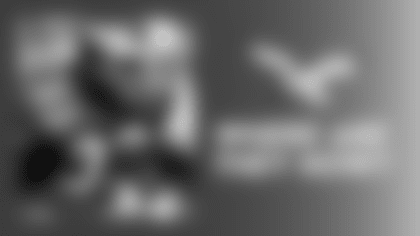
NFL Films senior producer Greg Cosell shares his observations of the upcoming opponent through the tape study of the team's previous game. Here are Cosell's notes from the Dallas Cowboys' loss to the Seattle Seahawks. Fran Duffy's Eagle Eye in the Sky will feature the All-22 of the Dallas offense on Thursday.
Ten Observations Of The Dallas Offense
1. Darren McFadden is not an overly skilled runner, but he runs hard and finishes with power.
2. What stands out about quarterback Matt Cassel is he's unwilling to turn it loose. There were some intermediate throws there against the Seahawks and he did not pull the trigger.
3. Here's a great example. The Cowboys started their fourth possession with a shot play off stretch-run play-action. Wide receiver Terrance Williams ran a deep comeback and Dez Bryant had a go route versus cornerback Richard Sherman. Bryant physically beat Sherman's press coverage off the line of scrimmage and got on top of Sherman. However, Cassel did not turn it loose after looking right at Bryant. Cassel's late checkdown to tight end Jason Witten went for 7 yards.
4. The Cowboys' run game was as diverse as it could be. They tried to control the pace and the tempo and at times they were successful.
5. Dallas tried to attack Seattle's predominant single-high safety coverage with inside vertical seams, but safety Kam Chancellor carried Witten so safety Earl Thomas could cheat to wide receiver Cole Beasley. It was a nice adjustment by the Seahawks so vertical seams would not break down the coverage.
6. Chancellor and linebacker K.J. Wright had very good games for the Seahawks. The only caveat is the Cowboys present no threat in the pass game with Cassel.
7. The Seahawks played four-boundary lock on a third-and-10 just outside the red zone. This was a great coverage with Witten the inside slot in 3x1 sets with Chancellor the quarters safety to the three-receiver side and Thomas the quarters safety to the x-iso side. The backside safety in quarters is responsible for three vertical so that puts Thomas on Witten.
8. Witten was wide open on an out-and-go from the boundary slot with 59 seconds remaining. Seattle played Cover 3 and Cassel did a good job moving single-high safety Thomas. Defensive end Cliff Avril drove tackle Doug Free back into Cassel and hit his arm just as he releasing the ball. The completion would have put the Cowboys right on the edge of field goal range.
9. The Cowboys came back to the same route concept two plays later, but this time Thomas stayed in the middle of the field and the throw to Witten was not there. Cassel ran out of the pocket and was sacked.
10. Dallas gained only 220 yards of total offense. They averaged only 3.9 yards per play.
Ten Observations Of The Dallas Defense
1. The Cowboys' base linebacker unit had Rolando McClain in the middle flanked by Sean Lee and Kyle Wilber at outside linebacker. Lee and McClain were the nickel linebackers.
2. First-round pick Byron Jones continued to play snaps at safety in the Cowboys' base defense. He also played slot corner in the nickel. Cowboys clearly did not feel Corey White could not match up in the slot with wide receiver Doug Baldwin. Jones continued to be utilized as the Cowboys' most versatile and multi-dimensional defender.
3. Jimmy Graham's 19-yard reception on first possession came out of shotgun power play-action versus Cowboys Cover 3. Graham from LOS TE position worked the void in the middle created by Lee, who reacted to the run action.
4. My sense was Cowboys thought Baldwin was the more dangerous receiver in 11 personnel packages. They matched Jones on Baldwin and were comfortable with a safety on Graham.
5. Barry Church was predominantly the box safety versus Seahawks base personnel packages with Jones the single-high safety. Jeff Heath for first time this season was a significant part of Cowboys safety rotation with Church and J.J. Wilcox.
6. Quarterback Russell Wilson was late to Graham on well-designed shot play, a post-cross combination on first-and-10 to start fourth possession. Seattle had hard stretch-run action out of 12 personnel with Graham running the deep cross versus Cowboys Cover 3. Graham was wide open within the timing of the route concept, but Wilson did not turn it loose at the right time. He was two seconds too late and was lucky it was not intercepted.
7. Dallas played its 3-2-6 subpackage for the first time in the two-minute situation at the end of the first half. The Cowboys came back to 3-2-6 personnel on Seahawks' field goal drive in the fourth quarter.
8. Tight end Luke Willson's 22-yard touchdown was the same play concept the Seahawks ran on their first possession that netted Graham's 19-yard catch: Shotgun power play-action with guard J.R. Sweezy pulling left to the same side of running back Marshawn Lynch off-set in the backfield. Lee reacted to the pulling guard and McClain reacted to Lynch in the backfield. That created the underneath void in the Cover 3. It was pitch and catch for Wilson and Willson.
9. Graham's 19-yard reception on first-and-10 in the fourth quarter came out of 21 personnel versus Cowboys base personnel. Cowboys played man free and matched up Jones on Graham, who motioned across the formation and beat Jones on a crosser.
10. Baldwin 15 yards on final field goal drive was same switch-release concept Seahawks used at the end of the first half that Wilson missed. This time he made the throw off play-action boot from under center moving away from defensive end Greg Hardy.























